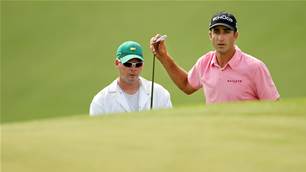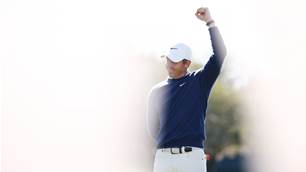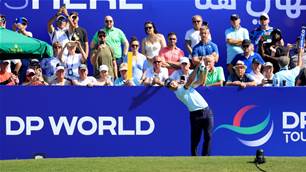Like just about every golfer, I suspect, I have spent my life searching for a better golf swing. It all started when I was very young, at a time when I was lucky enough to receive some vital lessons from great club professionals.
To a man, they were “old-school” coaches. There was no video camera. And I was coached the way everyone was coached at that time. It was “short left thumb” on the club. “Don’t get too loose with your hands.” That kind of stuff; all about finding my own “feel”.
Later, when the cameras did come along, the elite coaches were all using them. And the best players gravitated towards them as well. For me at least, one result of that was the difficulty in not becoming “vain”. I wanted to look like Greg Norman. I wanted to look like Nick Faldo. It varied, depending on my mood.
The other danger – one exacerbated by swing sequences in magazines – was that so many people started thinking of their swings as a series of positions rather than a single, flowing motion. There was a stage in the backswing where the club had to be in a certain spot. Likewise, the top of the backswing. And halfway down. And impact. And so on. The common factor was that everything had to be “neutral”, whatever that is. I even had tapes stuck to a mirror in my house, so that I could check I was in the right place at various stages of my swing.
Anyway, that sort of thinking dominated in the late 1980s and into the 1990s. And, to be fair, it all made sense. All the best players in the world at the time seemed to have pretty simple techniques. And that was what we all aspired to have. The guys who hit it the best all seemed to have great swings. They all looked good – Steve Elkington and Frank Nobilo the perfect examples. And that was how I wanted to be. I wanted to look good.
Faldo and David Leadbetter – who had famously rebuilt the former’s swing over a two-year period – had maybe the biggest influence at the time. Faldo had transformed himself from being merely a really good player, maybe 40th in the world, into a truly great player. So everyone wanted to do the same. Which, again, made sense. Faldo was the number-one player in the world and seemingly the best under pressure.
So suddenly everyone wanted to change their swings, following the Faldo-Leadbetter model. The search was on for the “perfect” technique. The problem was, however, that no one has ever become the best player in the world by copying someone else. And Faldo himself was something of an outlier. The end result was that hardly anyone of any significance followed his example and actually improved.
When I made it onto the European Tour back in the late 1990s, we were all out there trying to put together our swings on the range. At that time, players were still “teaching” other players. It was “I tried this the other day and it worked for me, why don’t you try it, too?” But very few of us had any idea what we were doing. It was all “tip-based” instruction. And vanity-based. We were still overly concerned with how the swing looked. Looking good meant it was good. But, of course, that wasn’t necessarily the case.
 More recently, the advent of Trackman has made the whole process a lot more scientific, rather than artistic. That device has definitely made it easier to get the correct driver in your hands and test equipment generally. But what all of those related products really do is identify what the club is supposed to be doing through the ball. So everyone works on that, instead of their set-up and position. Thus, the game has evolved to a point where impact and how that affects the ball has become the number-one “target”.
More recently, the advent of Trackman has made the whole process a lot more scientific, rather than artistic. That device has definitely made it easier to get the correct driver in your hands and test equipment generally. But what all of those related products really do is identify what the club is supposed to be doing through the ball. So everyone works on that, instead of their set-up and position. Thus, the game has evolved to a point where impact and how that affects the ball has become the number-one “target”.
RIGHT: Scottie Scheffler's swing insn't textbook, but his results are elite. PHOTO: Getty Images.
And what has been a big consequence of that thinking and emphasis? No one cares much about how the swing looks anymore. It’s all about speed. Young players on the range now hit a shot and look at a screen to see what the ball did.
There is an irony in that fact, of course. Today, the tours are populated by a huge percentage of players whose swings don’t vary that much. Which is very different from the past, when there were all kinds of unorthodox methods (again, whatever that means) on display. But maybe that is the lesson from all of this. Working on anything other than how the club goes through impact is the wrong path to take.
In the end, that’s all that matters.
I have to think that, back in the day, there were players who had figured that out. Amidst all the confusion, there had to have been those who paid attention to the ball and went from there. In that sense, Ben Hogan – one of the best ball-strikers ever – used his eyes as his Trackman. Through hitting thousands of balls, he knew that if he did X, the ball would absolutely do Y. Others would be the same. I know the late, great player and coach, Jackie Burke, could tell you what you needed to work on after seeing you make one swing.
The bottom line is that the era of cameras, swing sequence and standing in front of a mirror has all but gone. They were tangents which took us all in the wrong direction. That is what it feels like to me, at least. When I step onto the range at a tour event these days, it looks like everyone hits it well. Back in the 1990s, there were some guys who could hit 5-irons beautifully. Now there are 500 of those guys. And no, it can’t just be the superior equipment. I’ve seen many people hit today’s clubs poorly, although I would acknowledge that the driver is now a lot easier to hit, simply because the heads and sweet spots are bigger.
Is there a conclusion to all of this pondering? To me, there is. All that really matters is what the ball does. It doesn’t matter where, say, your wrists are angled in the backswing. Unless, of course, that adversely affects the ball. Look at the guy who is currently ranked the number-one player on the planet. Scottie Scheffler breaks all kinds of what would once have been considered “rules”, especially when it comes to his footwork. He swings the way he does because he knows that is the best way for him to produce the best “ball results”.
Scottie also focuses huge attention on how he grips the club, to the point where he uses what would once have been viewed as a gimmick – the grip guide – as an aid. Which is smart. Every day of his life, Scottie knows that his grip is in the right place. Back in the day we would all have been way too “snobby” to use such a thing. But Scottie works on his game more than anyone I’ve ever seen…
Remember that simple fact next time you get bogged down with complicated swing theory.
Related Articles

Ogilvy: The one time I played well enough at Augusta to actually win

Huggan: Adding-up majors should never be the sole measure of ultimate worth


.jpg&h=115&w=225&c=1&s=1)










